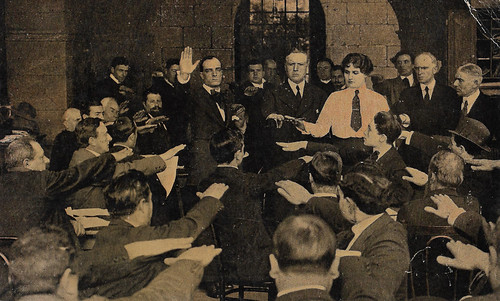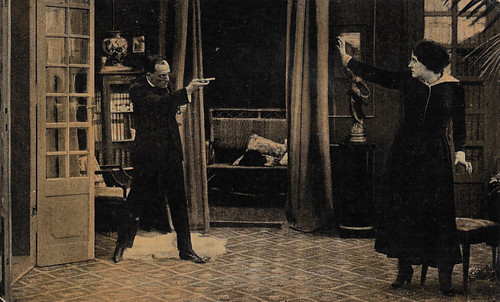
Spanish postcard by Chocolate Pi, Barcelona, no. 1. Photo: J. Verdaguer / Tiber Film. Ignazio Lupi, Floriana and Alberto Collo in Il potere sovrano (Baldassarre Negroni, Percy Nash, 1916).

Spanish postcard by Chocolate Pi, Barcelona, no. 2. Photo: J. Verdaguer / Tiber Film. Emilio Ghione and Hesperia in Il potere sovrano (Baldassarre Negroni, Percy Nash, 1916).

Spanish postcard by Chocolate Pi, Barcelona, no. 3. Photo: J. Verdaguer / Tiber Film. Diana d'Amore and Alberto Collo in Il potere sovrano (Baldassarre Negroni, Percy Nash, 1916).
Breaking the decorum
Il potere sovrano (Baldassarre Negroni, Percy Nash, 1916) takes place in a fictive Kingdom. Lotys (Hesperia) is the idol of the people. Therd (Emilio Ghione), a journalist, a man of action, and manager of the paper The Idea, is also beloved by his compatriots. Their ideals unite Lotys and Therd.
The King (Ignazio Lupi) lives distanced from his people and has left governing to his ministers. The government threatens Therd with arrest if he doesn't stop his actions. In the Royal Palace the crown prince (Alberto Collo) escapes monotony and etiquette through a secret affair with Gloria Ronsard (Diana d'Amore), The Queen (Floriana) knows about it but fears exposure and disgrace.
The people suffer from hunger, and Lotys decides to write to the King directly. Meanwhile, the Grand Chancellor (Alfonso Cassini), head of the government, raises import taxes and makes an agreement with a banker, Jost (Orlando), to fund military expenses. While the papers back the government, the King receives the letter that his government abuses his people and leaves them in hunger. He postpones his signature under the new arms law.
Incognito he visits a manifestation by Lotys and Therd and is so impressed by her speech he talks to her, but when the police arrive, he flees. The King is more and more impressed by Lotys and meets her more often, to the chagrin of Therd, who is secretly in love with her too. When the King hears about the secret deals between the banker and his Grand Chancellor, he is outraged. Lotys manages to obtain documents of the banker that will indicate the minister's corruption. In full uniform and before his whole government The King has the banker arrested.
The people hear about the arrest. The King, eager to get closer to his people, decides to open the Palace of Fine Arts. Lotys is in the first row and cries out her love to him when he passes, breaking the decorum, and passing out. That night Therd sees the King leaving Lotys' house, and in a jealous fit, he demands Lotys to choose him instead. She refuses, so he shoots her. Her last words to the King are forgiving for Therd, claiming she committed suicide because of the impossible situation. The King spreads her ashes out into the sea.
Il potere sovrano was based on the novel 'Temporal Power: a Study in Supremacy' (1902) by Marie Corelli and was scripted by the two directors. Cinematographers were Giorgio Ricci and Antonio Cufaro, and the sets were designed by Giulio Lombardozzi. The film got its censorship card on 17 October 1916, but premiered quite sometime later, in Rome on 10 January 1917. The censor forbid to use the English title in Italy, but that title was still often used. Though the press was not in favour, audiences flocked to the cinemas to see the film.

Spanish postcard by Chocolate Pi, Barcelona, no. 4. Photo: J. Verdaguer / Tiber Film. Publicity still for Il potere sovrano (Baldassarre Negroni, Percy Nash, 1916). Ignazio Lupi as the King on the left and Alfonso Cassini as the Lord Chancellor on the right (the blond, elder man). The man in the middle may be Orlando (banker Jost).

Spanish postcard by Chocolate Pi, Barcelona, no. 5. Photo: J. Verdaguer / Tiber Film. Hesperia in Il potere sovrano (Baldassarre Negroni, Percy Nash, 1916).

Spanish postcard by Chocolate Pi, Barcelona, no. 6. Photo: J. Verdaguer / Tiber Film. Hesperia and Emilio Ghione in Il potere sovrano (Baldassarre Negroni, Percy Nash, 1916).
Sources: Sempre in penombra (Italian), IMDb and the collectors cards.
This post was last updated on 29 January 2023.
No comments:
Post a Comment